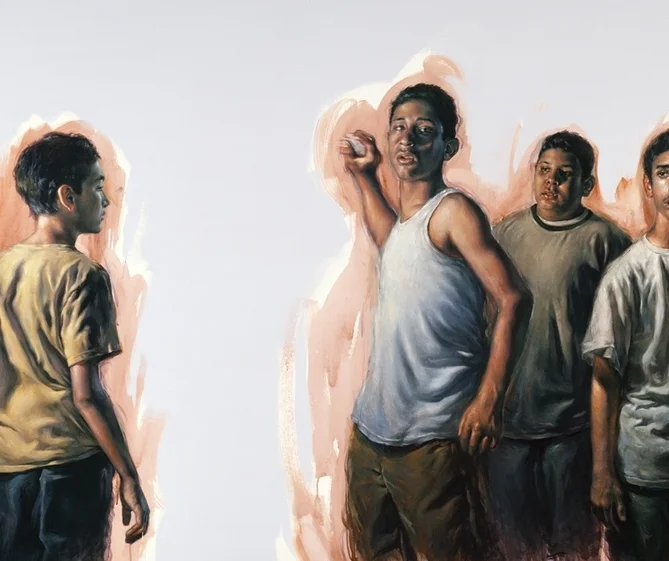April 2009
By Emberly Modine for Buzzine.com
The Korean Cultural Center in Los Angeles held an opening ceremony for their 16th annual juried exhibition, which has been gaining recognition since 1993. Fourteen artists were chosen based on the ability their work had in capturing the essence of the show. One of the shows jurors, Marc Pally, mentioned that thematically, the show was curated similarly to this years Whitney Biennial; in that the subject of a society under stress would act as the main concern.
The jury settled upon a group of works that spoke to a certain kind of “confrontation of the real: stylistic, relationally or thematically”. Walking around, my impression was that the exhibit as a whole was expertly curated; there was a good balance of material and approach, diverse enough that each piece was able to stand out amongst its neighbors. I would like to highlight the following work as remarkable, in my opinion.
The most formal of the pieces were the photographs. Kireilyn Barbers’ series of studies taken from hotel rooms were astonishing in her use of depth of field and color. The attention that she payed to the detail of sterile surfaces of spaces cleaned everyday created a great tension with the fact that they are used by many people for the most intimate of daily rituals. Jennifer Brandon’s work followed a similar thread in subject matter, but threw a wrench in it with her long rectangular studies of a mattress in the stages of its innards being ripped out. We associate the bed and bedroom as a place of rest and privacy, both Barber’s and Brandon’s work assume an uncomforting aspect - one of home where the evidence of living is wiped away daily, the other where the altar of the most intimate of spaces is violently assault
A painting by Joseph P. Gerges, “Casting the First Stone”, depicts a group of young men looking uncertainly at the viewer, some of them with rocks in their hands, one with an arm cocked and ready to throw. The figures are rendered expertly in oils, softly and down to the last details of reflection in their eyes. The paint strokes loosen at the edges, almost causing halos around them that vibrate into thick rose-colored swatches contrasting with the sky blue ground color. The lighting and the treatment of the figures is almost seductive in the rich contrast and quality of the texture, but truly the expressions of the young men were emotive for me. I realized that the artist was not portraying the initial meaning in the title - referring to the Biblical passage - but the point in adolescence that every human comes to. The point in our lives where we choose a moral side, whether it be prompted by society or religion; and the uncertainty that is felt when acting upon it the first time; throwing our first stone; unsure if the accuracy of our judgment is absolute.
Also notable were the collages of Jaami Abdul-Khaliq Abdul-Samad. Exquisite in their detail and construction, he was able to accomplish something that I have rarely seen an artist of this genre do: take found images and create something thematic throughout several different pieces without re-using the same source too often. Victorian illustration clippings combine with old record labels and detailed diagrams to somehow become portraits of Egyptian Pharaohs and African Queens. The artist had a true gift for visual poetry, especially apparent in his ability to appropriate the imagery of one culture and use it to describe his relationship to another, one that he feels are his roots perhaps?
Along with being included in the exhibition, trophies and cash prizes were handed out to the chosen artists. The “First in Show” went to Ariel Erestingcol for his work “LZC646″ (pictured top), which refers to the license plate number of the Oklahoma City Bomber. Erestingcol’s work is truly remarkable; not only for his use of non-traditional materials - tiny craft beads make up the entire 6×8 foot piece - but for the process in which he approaches his art making. An image of the Alfred P. Murrah Federal Building right after the explosion is taken and pixelated into a grid. The artist then uses that grid to re-render it using fusion beads - each bead representing a pixel. Erestingcol describes this process as an attempt at comprehension, each unit in the image representing a modicum of understanding an event which has been filtered by the media and presented to us digitally.
The comprehensive theme throughout the exhibit was surprising, I kept remarking at the luckiness of the jurors who had the task of curating it. What are the chances at finding consistent strain of subject matter in a limited number of submissions? Perhaps the theme of distress has become more common, even amongst diverse backgrounds, as artists reflect the state of the world around them.The exhibition runs through April 24th.
